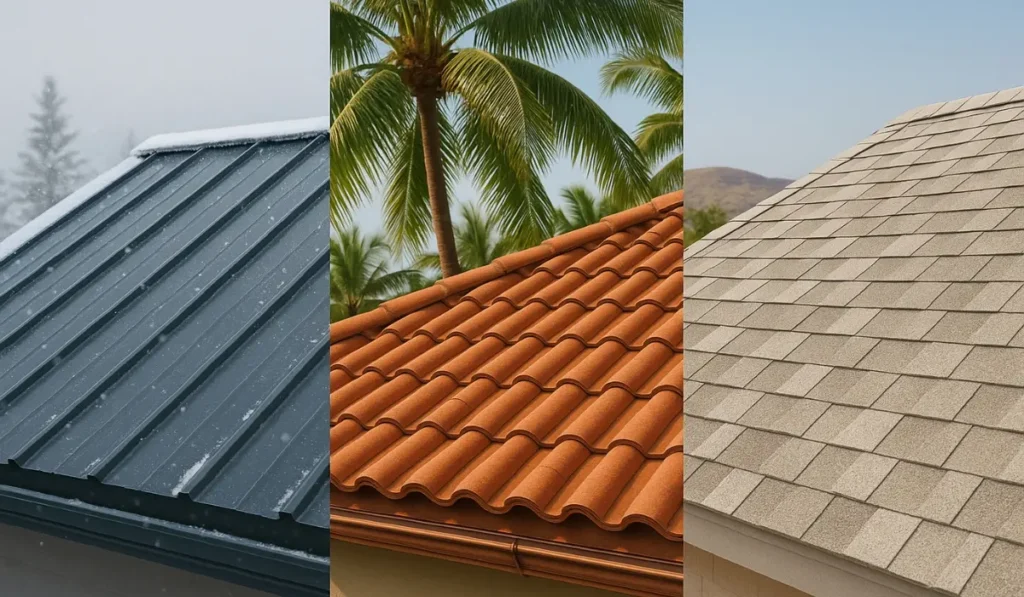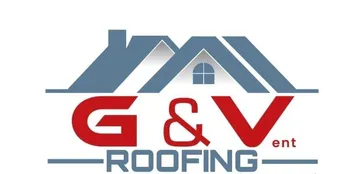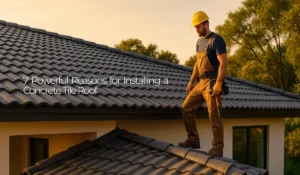
A concrete tile roof is a durable roofing system made from a mixture of cement, sand, water, and oxide pigments. These components are shaped under high pressure using a hydraulic press, then cured through a drying process to harden. The result is a robust, interlocking roofing tile that mimics traditional materials like clay or slate.
What are the components of a concrete tile roof?
- Concrete mix: A blend of cement, sand, and water.
- Pigment oxide: Adds color to the tiles during manufacturing.
- Interlocking system: Ensures wind and water resistance.
- Profiles: Typically flat, S-shaped (Spanish), or barrel-style.
- Surface texture: Smooth, brushed, or textured finishes.
This roofing system has become a go-to choice in both residential and commercial construction due to its cost-efficiency, aesthetic variety, and long lifespan.
Next, discover why homeowners and builders increasingly choose this material.
Benefits of Installing a Concrete Tile Roof
Concrete tile roofing offers superior performance in multiple categories: durability, energy efficiency, aesthetic appeal, and property value enhancement. These tiles outperform asphalt shingles and even some metal options in key long-term benefits.
Why install concrete tile roofing?
- Exceptional durability: Resists harsh weather, impact, and fire.
- Thermal efficiency: Reduces heat transfer into the attic.
- Visual appeal: Enhances home exterior with customizable styles.
- Long lifespan: Lasts up to 75 years with low upkeep.
- High ROI: Boosts resale value and reduces long-term maintenance costs.
- Eco-friendly: Made from natural, recyclable materials.
- Storm resilience: Handles wind, rain, and hail better than most materials.
These roof benefits translate into real-world savings and better comfort for homeowners.
Let’s look deeper into durability and longevity next.
In this guide, you’ll find the 10 most critical warning signs of roof damage that should never be ignored, plus practical tips on how to assess them and act fast.
Lifespan and Durability
Concrete tile roofs last 50 to 75 years, far exceeding the average 20–30 year lifespan of asphalt shingles. They withstand severe weather conditions, UV radiation, thermal cycling, and freeze-thaw cycles without losing structural integrity.
How durable is a concrete tile roof?
- Class A fire rating: The highest rating for flame resistance.
- Impact-resistant: Strong against hail and falling debris.
- UV-resistant: Surface treatments help prevent material breakdown.
- Fracture resistance: Resists cracking under pressure.
- Decay protection: Unaffected by rot or insect damage.
This makes them ideal for regions with extreme weather, high humidity, or high sun exposure.
Next, we’ll break down how concrete tiles contribute to energy efficiency.
Energy Efficiency and Insulation
Concrete tile roofs significantly improve home energy performance through their thermal mass and reflectivity. These properties reduce the need for active cooling, especially in warmer climates.
How energy-efficient are concrete roof tiles?
- Thermal lag: Slows down heat transfer into the attic.
- Radiant barrier: Optional coatings reflect solar heat.
- Cool roof system: Lower CRRC-rated tiles reduce heat absorption.
- Attic ventilation: Works with venting systems for better airflow.
- Lower cooling load: Up to 20% energy savings in hot climates.
The insulation value of concrete tiles also enhances indoor comfort, even during temperature swings.
Next, we explore the design flexibility and curb appeal of this roofing option.
Concrete Tile Roof Design and Curb Appeal
Concrete tiles come in an array of styles, colors, and profiles to match any architectural theme. From Mediterranean villas to modern homes, they provide visual versatility.
What design options are available for concrete tile roofing?
- Profiles: Flat tiles, S-tiles, and high barrel tiles.
- Colors: Earth tones, vibrant blends, or custom finishes.
- Surface textures: Matte, glossy, sanded, or woodgrain.
- Mimics: Looks like clay, slate, or even wood shingles.
- Pattern variety: Random staggered layouts for custom design.
A decorative concrete tile roof not only boosts curb appeal but also aligns with homeowners’ personal style and architectural needs.
Let’s walk through how these roofs are installed.
Concrete Tile Roof Installation Process
Installing a concrete tile roof involves careful planning, structural assessment, and precision. These tiles are heavier than asphalt and require proper support.
What are the steps to install a concrete tile roof?
- Inspection of roof decking: Ensure it’s structurally sound.
- Install underlayment: Acts as a moisture barrier.
- Place battens: Helps secure the tiles in place.
- Install drip edges and flashing: Prevents water infiltration.
- Lay and fasten tiles: Use correct tile overlap and nail patterns.
- Final checks: Ensure alignment, seal joints, and clean surface.
How long does installation take?
- Timeframe: Typically 7–10 days for a standard-size home.
- Labor: Skilled roofers required due to tile weight and layout precision.
- Load calculation: May need structural reinforcements due to tile weight (600–1,100 lbs per square).
Next up: how to maintain and preserve your tile roof.
Maintenance Requirements and Tips

While concrete tile roofs are low-maintenance, regular care extends their life and prevents issues. Maintenance involves visual inspections, debris removal, and occasional cleaning.
How to maintain a concrete tile roof?
- Inspect twice yearly: Look for loose tiles, damaged flashing, or underlayment exposure.
- Clean safely: Avoid pressure washing; use gentle cleaners for moss or algae.
- Treat efflorescence: White residue from minerals; clean with vinegar solution.
- Avoid walking: Tiles can crack under weight—use boards to distribute pressure.
- Seal joints: Every few years, reseal flashing and valleys to prevent leaks.
By keeping a consistent roof inspection schedule, homeowners can avoid costly repairs and ensure performance.
Let’s look at the cost and return on investment now.
Cost of Concrete Tile Roof
Concrete tile roofing has a higher upfront cost than asphalt but offers significant long-term savings through longevity and low maintenance.
What is the cost of installing a concrete tile roof?
Cost Factor | Price Range (USD) |
Materials per square | $300 – $500 |
Installation per square | $350 – $600 |
Total per 2,000 sq ft | $13,000 – $22,000 |
Lifespan | 50–75 years |
ROI | High (due to durability) |
Cost comparison:
- Asphalt shingles: $5,000–$10,000, lasts 20–30 years.
- Metal roofing: $15,000–$30,000, lasts 40–70 years.
- Slate: $20,000+, heavy and brittle.
- Concrete tiles: Balance of longevity, performance, and aesthetics.
Also, some insurance providers offer lower premiums due to fire and storm resistance.
Next, how does concrete tile measure up against other materials?
Concrete Tile Roof vs Other Roofing Options
Concrete tile roofs stand out in key areas when compared to asphalt, metal, slate, and clay.
How does concrete tile compare to other roof types?
Roof Type | Lifespan | Cost | Weight | Appearance | Maintenance |
Asphalt Shingle | 20–30 yrs | Low | Light | Basic | High |
Metal Roof | 40–70 yrs | High | Medium | Modern | Medium |
Clay Tile | 50–100 yrs | Very High | Very Heavy | Traditional | Medium |
Concrete Tile | 50–75 yrs | Moderate | Heavy | Versatile | Low |
Concrete tiles offer the best blend of affordability, durability, and design options for long-term investment.
Let’s explore how well these roofs perform in different environments.
Suitability for Different Climates

Concrete tile roofs adapt well to various climates, from arid deserts to snowy mountain areas.
Are concrete tiles good for extreme weather?
- Hot climates: Reflect solar heat, reduce AC usage.
- Cold climates: Resist freeze-thaw cycles and maintain shape.
- Storm-prone areas: Hold up to 120–150 mph winds with proper fastening.
- Snow loads: Can handle up to 200 lbs/sq ft depending on roof pitch and support.
They meet most regional building codes and remain thermally efficient year-round.
Now, we’ll identify and address some common tile roof issues.
Common Issues and Repairs
Although strong, concrete tiles can suffer damage from improper installation, foot traffic, or aging underlayment.
What are common concrete tile roof problems?
- Tile breakage: From falling branches or walking on roof.
- Moss and algae: Especially in humid regions.
- Underlayment deterioration: Leads to leaks after 30–40 years.
- Efflorescence: Harmless but affects appearance.
- Mortar erosion: Especially on ridge caps or valleys.
How to fix tile roof issues:
- Replace cracked tiles individually.
- Use anti-algae treatments annually.
- Reseal joints and flashing periodically.
- Replace underlayment after 30 years if needed.
Last, we answer key questions homeowners often ask.
Concrete Tile Roof FAQs
How long do concrete tiles last?
50 to 75 years with proper maintenance.
Can you walk on a tile roof?
Yes, but cautiously. Use boards to spread weight.
Do tiles fade over time?
Yes, slightly. Surface pigment may fade due to UV.
Is it normal to see white powder (efflorescence)?
Yes. It’s mineral residue and is not harmful.
Do I need to replace the whole roof if a few tiles crack?
No. Tiles can be replaced individually without full replacement.
Want More High-Quality Roofing Projects on Long Island?
G&V Roofing delivers trusted craftsmanship, reliable service, and local expertise that turns property owners into lifelong clients—all from one professional source.
Our Services:







Learn About:





🏡 Looking to Upgrade Your Roof or Protect Your Property Investment?
Whether you’re a homeowner looking for reliable roof solutions or a property manager seeking fast, expert repairs—G&V Roofing is your go-to Long Island partner for long-lasting protection and peace of mind.
 Follow Us for the Latest in Roofing Care, Property Protection & Home Improvement:
Follow Us for the Latest in Roofing Care, Property Protection & Home Improvement:








